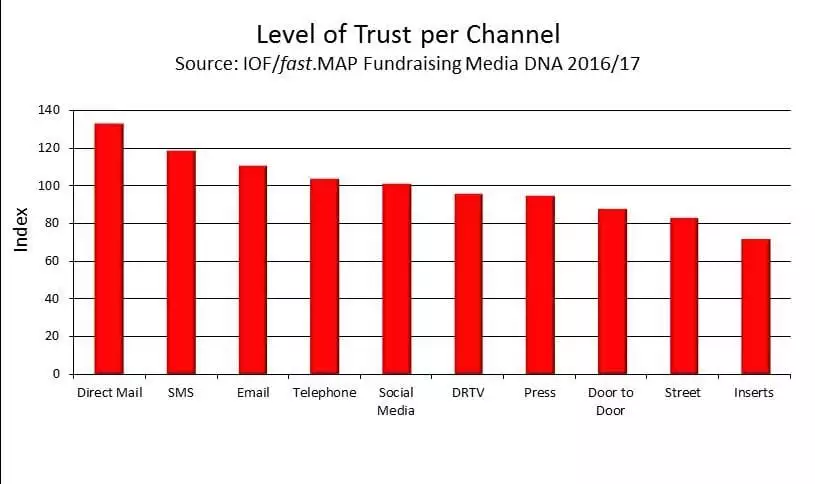Fundraising Media DNA: which channels build trust?
Our final analysis of the fastMAP and Institute of Fundraising’s Fundraising Media DNA report 2016 looks at which channels build trust in donors.
Key headlines
- Research suggests that written communications, such as Direct Mail, SMS and Email are seen as most trustworthy
- Over-55s seem to particularly trust Direct Mail, Email and Social Media fundraising
- Social Media also generates trust from High Donors, as well as DRTV fundraising
- Download your copy of the Fundraising Media DNA report and Infographics using the free download code UKFU16
Each channel generates different levels of trust
Whilst each fundraising channel creates diverse responses and attribute scores, some channels are seen as more trustworthy than others. The research of Fundraising Media DNA suggests that, for example, written communication seems more trustworthy than other fundraising channels.
Face-to- face communications, such as Door to Door or Street fundraising, could do better with regards to the trustworthy attribute profiles (Door to Door Trustworthy Index: Overall, 88 vs. Street Trustworthy Index: Overall, 83). Nevertheless, both channels are seen as welcomed by potential donors (Door to Door Welcomed Index: Overall, 110 vs. Street Welcomed Index: Overall, 90). These findings suggest that it might not be the channel itself generating low levels for the trustworthy attribute, but rather, the delivery and execution of the fundraising which could be improved.
Advertisement
Different donor profiles trust different channels
Press, DRTV, Social Media and Telephone fundraising communications are seen as rather trustworthy, scoring near average levels for this attribute (Press Trustworthy Index: Overall, 95 vs. DRTV Trustworthy Index: Overall, 96 vs. Social Media Trustworthy Index: Overall, 101 vs. Telephone Trustworthy Index: Overall, 104).
Over-55s and High Donors find DRTV and Social Media particularly trustworthy (DRTV Trustworthy Index: 55+, 107 vs. Social Media Trustworthy Index: 55+, 123 vs. DRTV Trustworthy Index: High Donors, 102 vs. Social Media Trustworthy Index: High Donors, 121). Press and Telephone however, appear most trustworthy to Low Donors (Press Trustworthy Index: Low Donors, 109 vs. Telephone Trustworthy Index: Low Donors, 134).
These findings suggest that the chosen channel of a fundraising campaign could attract a diverse audience as well as a different approach or content. This is especially interesting when marketers combine different channels in their fundraising campaigns. In this way, they could gain the trust of several audiences in addition to being approachable on more than one channel.
Written communications seem most trustworthy
The channels that potential donors seem to trust most on an overall level are Email, SMS and Direct Mail (Email Trustworthy Index: Overall, 111 vs. SMS Trustworthy Index: Overall, 119 vs. Direct Mail Trustworthy Index: Overall, 133).
This leads to the conclusion that the most trusted channels are channels that are also seen as highly personalised (Email Personalised Index: Overall, 139 vs. SMS Personalised Index: Overall, 145 vs. Direct Mail Personalised Index: Overall, 125). This result can be regarded as crucial information, especially for new and less established charities.
It is important to note that a likely response to these trusted channels is to research further (Email Research Index: Overall, 104 vs. SMS Research Index: Overall, 108 vs. Direct Mail Research Index: Overall, 97). Charities can benefit from this if they combine several channels in their fundraising campaigns. Potential donors would be referred to another channel that might be considered less trustworthy but is more likely to lead to a direct response.
What do people say about different levels of trust?
“By studying the merits of each channel, such as high trust, the insights can enable fundraisers to maximise the effectiveness of a campaign with a sophisticated multi-channel approach. Carefully combining a mix of media that balances one medium’s weakness with another’s strength, can help create more effective campaigns, in turn, generating more vital income for your cause.”
David Cole, Managing Director, fast.MAP
“As fundraisers and charities review their fundraising activity the information and insight that reports like Fundraising Media DNA bring is invaluable. The more we know about how supporters and the public respond to different fundraising channels and communications, the more we can plan great campaigns that inspire people. It’s important that we understand people’s preferences and responses so that we can tailor fundraising activity and engage them in a way that is likely to give them the best experience of fundraising and establish long-term relationships.”
Daniel Fluskey, Head of Policy Research, Institute of Fundraising
“Recent research has shown a dramatic and damaging reduction in public trust and confidence in charities following recent high-profile media exposures.”
“The Commission of the Donor Experience will encourage new opportunities and possibilities, helping to restore public trust, confidence and awareness of the joy of giving. By placing concern for the donor experience at the heart of fundraising, we have the chance to help charities better engage, inspire and grow a willing supporter base and raise more money, more effectively.”
Richard Spencer, Director, The Commission on the Donor Experience
To find out more about how people view and interact with different fundraising channels, download Fundraising Media DNA 2016/17 – free, (normally £50) with the following code: UKFU16.








